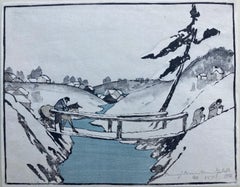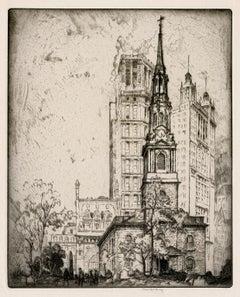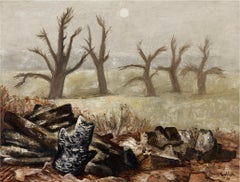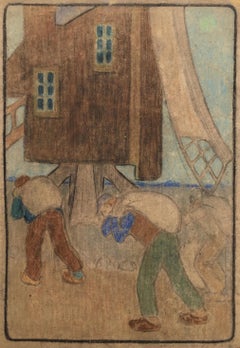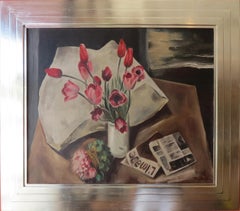Bror Julius Olsson Nordfeldt Art
to
1
7
1
4
3
3
1
1
2
Overall Height
to
Overall Width
to
4
2
1
3
2
2
2
1
1
1
1
1
1
1
1
7
2
2
1
2
7
6,961
3,321
2,514
1,213
3
3
3
3
2
Artist: Bror Julius Olsson Nordfeldt
The Bridge
By Bror Julius Olsson Nordfeldt
Located in Santa Monica, CA
B. J. O. NORDFELDT (Bror Julius Olsson) 1878-1955)
THE BRIDGE, 1906
Color woodcut signed, dated 1906 and numbered 150 in pencil. Image 8 x 10 - small margins as issued. 4 corners tipped to acid free support board. Nordfelt is one of the most important early twentieth century American Masters of the Color woodcut. This 1906 work predates many of the other woodcut masters. Nordfeldt had a peculiar numbering system. The number is not necessarily the edition number.
Frances H. Gearhart, Blanche Lazzell, William S. Rice, Gustave Baumann, Margaret Patterson, Norma Basset Hall. Waldo Chase.
Category
Early 1900s American Modern Bror Julius Olsson Nordfeldt Art
Materials
Woodcut
St. Paul's Church (St. Paul's Chapel, New York City)
By Bror Julius Olsson Nordfeldt
Located in Myrtle Beach, SC
B.J.O. Nordfeldt, 'St. Paul's Church' (St. Pauls' Chapel), etching, edition not stated, c. 1915. Signed in pencil. A superb, richly-inked impression, with skillfully controlled plate tone, printed on off-white, antique, laid paper; the full sheet with margins (5/8 to 2 1/4 inches), in very good condition. Scarce. Matted to museum standards, unframed.
An impression of this work is in the permanent collection of the Smithsonian American Art Museum.
ABOUT THE ARTIST
A solo exhibition of Nordfeldt’s etchings and woodcuts was presented by the Smithsonian Institution in 1926. In 1920, Nordfeldt had a one-man show at the Chicago Arts Club. In 1926, he won the bronze medal at the sesquicentennial exposition in Philadelphia and the Logan Medal at the Art Institute of Chicago. In 1927, he won the first annual prize from the Brooklyn Society of Etchers, and the following year he won first prize from the Chicago Society of Etchers. In 1929, Nordfeldt had a one-man show at the Denver Art Museum. Nordfeldt's work is held in numerous museum collections including Amon Carter Museum of Western Art, Ft. Worth; Anschutz Collection, Denver; Art Institute of Chicago; Biblioteque d’Art et d’Archeologie, Paris; British Museum, London; Corcoran Gallery of Art, Washington, DC; Los Angeles County Museum; Metropolitan Museum of Art, New York City; Museum of Fine Arts, Santa Fe; National Museum of American Art, Smithsonian Institution, Washington, DC; National Gallery, Sydney, Australia; Phillips Collection, Washington, DC.
ABOUT ST. PAUL'S CHAPEL
St. Paul's Chapel, nicknamed "The Little Chapel That Stood", is an Episcopal chapel located at 209 Broadway, between Fulton Street and Vesey Street, in Lower Manhattan, New York City. Built in 1766, it is the oldest surviving church building in Manhattan, and one of the nation's finest examples of Late Georgian church architecture. It is a New York City Landmark and a National Historic Landmark.
The Hearts of Oak, a militia unit organized early in the American Revolutionary War, and composed in part of King's College (later, Columbia University) students, would drill in the Chapel's yard before classes nearby. Alexander Hamilton was an officer of this unit. The chapel survived the Great New York City Fire of 1776 when a quarter of New York City (then confined to the lower tip of Manhattan), including Trinity Church, burned following the British capture of the city after the Battle of Long Island during the American Revolutionary War. George Washington, along with members of the United States Congress, worshipped at St. Paul's Chapel on his Inauguration Day, April 30, 1789. Washington also attended services at St. Paul's during the two years New York City was the country's capital. Above Washington's pew is an 18th-century oil painting of the Great Seal of the United States, adopted in 1782.
The rear of St. Paul's Chapel faces Church Street, opposite the east side of the World Trade Center site. After the attacks on September 11, 2001, which led to the collapse of the twin towers of the World Trade Center, St. Paul's Chapel served as a place of rest and refuge for recovery workers at the WTC site. For eight months, hundreds of volunteers worked 12-hour shifts around the clock, serving meals, making beds, counseling and praying with firefighters, construction workers, police, and others. Massage therapists, chiropractors, podiatrists, and musicians also tended to their needs.
The church survived without even a broken window. Church history declares it was spared by a miracle sycamore on the northwest corner of the property that was hit by debris. The tree's root has been preserved in a bronze memorial...
Category
1910s American Impressionist Bror Julius Olsson Nordfeldt Art
Materials
Etching
B.J.O. Nordfeldt - Moon in Mist - monochromatic grays
By Bror Julius Olsson Nordfeldt
Located in Miami, FL
Nordfeldt's misty and moody monochromatic modernist landscape is reminiscent of Marsden Hartley. Signed lower right. The plaque reads B.J.O Nordfeldt "Moon in Mist - The painting l...
Category
1940s Post-Impressionist Bror Julius Olsson Nordfeldt Art
Materials
Canvas, Oil
WINDMILL AND WORKERS (Large Pastel)
By Bror Julius Olsson Nordfeldt
Located in Santa Monica, CA
B.J.O. NORDFELDT (Swedish/American 1878 – 1955)
(WINDMILL AND WORKERS). c.1900. Color pastel on colored paper, unsigned. 22 ¼ x 15”. Sheet: 24 ½ x 18 ¼”. In 1900 Nordfeldt studied ...
Category
Early 1900s Modern Bror Julius Olsson Nordfeldt Art
Materials
Pastel
Broad Street (Wall Street)
By Bror Julius Olsson Nordfeldt
Located in Myrtle Beach, SC
B.J.O. Nordfeldt, 'Broad Street (Wall Street)', etching, edition not stated, c. 1915. Signed in pencil. A superb impression, with rich burr, selectively wiped plate tone, and inky plate edges, on cream wove paper; the full sheet with margins (3/4 to 1 1/4 inches), in excellent condition. Printed by the artist. Matted to museum standards, unframed.
Impressions of this work are in the permanent collections of the Fine Arts Museums of San Francisco, Princeton University, Smithsonian American Art Museum.
A view looking down Broad Street past the New York Stock Exchange Building on the right with the columned Federal Hall...
Category
1910s American Impressionist Bror Julius Olsson Nordfeldt Art
Materials
Etching
"Red Tulips, Paris"
By Bror Julius Olsson Nordfeldt
Located in Lambertville, NJ
Jim’s of Lambertville is proud to offer this artwork by:
Bror Julius Olsson “B.J.O.” Nordfeldt (1878 – 1955)
Bror Julius Olsson was born in Tullstrop, Sweden in 1878. He immigrated to the United States in 1891, later adopting his mother’s maiden name of Nordfeldt. Beginning his art studies at the Art Institute of Chicago where he was chosen to assist fellow artist, Albert Herter, with a large mural project for the McCormick Harvester Company. In 1900, he was sent to Paris by McCormick to help set up the completed mural at the Paris Exposition. While there, he studied briefly at the Academie Julian before traveling to England to study woodblock printmaking under F. Morley Fletcher. Returning to Chicago in 1903, Nordfeldt would spend the next ten years painting mainly figurative works in an academic style similar to that of the Old Masters. By the mid-teens he had developed a bold dramatic modernist style and divided his time between New York and Provincetown, Massachusetts. There, he invented the “Provincetown Print...
Category
1930s American Modern Bror Julius Olsson Nordfeldt Art
Materials
Canvas, Oil
"Shrimp"
By Bror Julius Olsson Nordfeldt
Located in Lambertville, NJ
Signed Lower Right
Bror Julius Olsson “B.J.O.” Nordfeldt (1878 - 1955)
Bror Julius Olsson was born in Tullstrop, Sweden in 1878. He immigrated to the United States in 1891, later adopting his mother’s maiden name of Nordfeldt. Beginning his art studies at the Art Institute of Chicago where he was chosen to assist fellow artist, Albert Herter, with a large mural project for the McCormick Harvester Company. In 1900, he was sent to Paris by McCormick to help set up the completed mural at the Paris Exposition. While there, he studied briefly at the Academie Julian before traveling to England to study woodblock printmaking under F. Morley Fletcher. Returning to Chicago in 1903, Nordfeldt would spend the next ten years painting mainly figurative works in an academic style similar to that of the Old Masters. By the mid-teens he had developed a bold dramatic modernist style and divided his time between New York and Provincetown, Massachusetts. There, he invented the “Provincetown Print...
Category
1940s American Modern Bror Julius Olsson Nordfeldt Art
Materials
Canvas, Oil
Related Items
Vintage Abstracted Fauvist Birch Tree Landscape
By Libby Beth Seligman
Located in Soquel, CA
Vivid abstracted landscape in vibrant fauvist hues of birch trees in green field by Libby Beth Seligman (American, b. 1958), 1977. Signed and dated lower right corner. Presented in r...
Category
1970s Fauvist Bror Julius Olsson Nordfeldt Art
Materials
Canvas, Oil
H 28.25 in W 28.25 in D 0.75 in
Fauvist Ocean Wave and Sunset, 1920's Seascape
By John Henry Ramm
Located in Soquel, CA
Compelling fauvist seascape with boldly colorful ocean waves and glowing sunset by Northern California artist John Ramm (American, 1879-1948), 1929. Impasto brush strokes add depth and interest to high voltage color palette. Signed lower right corner and dated on stretcher "29" . Condition: Good; minor edge losses professionally restored/in-painted. Signature slightly augmented to enhance readability. Image size: 22"H x 28"W.
The son of German immigrants, John Henry Ramm was the son of German immigrants, and his father had been a Duke in his native land. Ramm moved to San Francisco in 1893 and worked as an apprentice to a photographer. He married Nettie Hoist in Sacramento and they lived in San Francisco. He was a close friend of painter Manuel Valencia...
Category
1920s Fauvist Bror Julius Olsson Nordfeldt Art
Materials
Canvas, Oil
Starry Night after Vincent Van Gogh Saint Remy 1889 by Emerging British Artist
By Anthony D Padgett
Located in Preston, GB
Starry Night (after Van Gogh Saint Remy 1889) by British Artist Anthony D Padgett BA MA PGDip, born 1969. Original Sculpture and 67 paintings inspired by the art, life and letters of...
Category
2010s Post-Impressionist Bror Julius Olsson Nordfeldt Art
Materials
Canvas, Oil
H 15.75 in W 19.69 in D 0.6 in
The Olives, Santa Monica Canyon - Gift by the Artist to Mary Pickford
By Arthur Millier
Located in Soquel, CA
Beautiful, simple rural scene from the early 1920s by listed British-American artist Arthur Millier (1893-1975). Signed by the artist, right corner below the image; titled lower center edge of paper below the mat "The Olives, Santa Monica Canyon" . Presented to Mary Pickford...
Category
1920s American Impressionist Bror Julius Olsson Nordfeldt Art
Materials
Paper, Printer's Ink, Etching
H 11.25 in W 13.13 in D 0.25 in
Ocean California (Diptych)
By Ivana Milosevic
Located in Los Angeles, CA
Ivana Milosevic creates vibrant, pulsing cityscapes that emphasize color and texture. She uses palette knives and bushes to carve building structures into layers of paint. Small shad...
Category
21st Century and Contemporary Post-Impressionist Bror Julius Olsson Nordfeldt Art
Materials
Canvas, Oil
CANAL BRIDGE AMSTERDAM
By John Marin
Located in Santa Monica, CA
JOHN MARIN (1872 -1953)
CANAL BRIDGE AMSTERDAM, 1906 (Zigrosser 13 i/ii)
Etching, drypoint and plate tone. A PROOF IMPRESSION of the 1st state, Annotated...
Category
Early 1900s American Impressionist Bror Julius Olsson Nordfeldt Art
Materials
Etching
Modern Abstracted Still-Life with Antique Coffee Grinder by Anthony Rappa
By Anthony Rappa
Located in Soquel, CA
Modern Abstracted Still-Life with Antique Coffee Grinder by Anthony Rappa
Modern textural still-life by California artist Anthony Rappa (America...
Category
1980s American Modern Bror Julius Olsson Nordfeldt Art
Materials
Oil, Cardboard, Canvas
H 24 in W 30 in D 0.5 in
'Laguna Cove' — 1930s American Modernism
By Paul Landacre
Located in Myrtle Beach, SC
Paul Landacre, 'Laguna Cove', wood engraving, 1935; edition 60 (16 printed), 2nd edition 150 (6 printed), Woodcut Society 200, Wien 247. Signed and titled in pencil. A brilliant, black impression, on cream wove Japan, with full margins (3/4 to 1 3/4 inches), in excellent condition. Archivally matted to museum standards, unframed.
This impression is from the edition published for the Twentieth Presentation Print of the Woodcut Society, 1941. Printed by Torch Press, Cedar Rapids.
Literature: Reproduced in 'James Swann...
Category
1930s American Modern Bror Julius Olsson Nordfeldt Art
Materials
Woodcut
'Hill' — 1930s American Modernism
By Paul Landacre
Located in Myrtle Beach, SC
Paul Landacre, 'Hill', wood engraving, 1936, edition 60 (only 54 printed); only 2 impressions printed in a second edition of 150. Signed, titled, and numbered '49/60' in pencil. Wien...
Category
1930s American Modern Bror Julius Olsson Nordfeldt Art
Materials
Woodcut
'Taos Placita' — 1940s Southwest Regionalism
By Gustave Baumann
Located in Myrtle Beach, SC
Gustave Baumann, 'Taos Placita', color woodcut, 1947, edition 125. Baumann 132. Signed, titled, and numbered '20-125' in pencil; with the artist’s Hand-in-Heart chop. A superb, richly-inked impression, with fresh colors, on fibrous oatmeal wove paper; the full sheet with margins (2 to 3 1/8 inches); slight rippling at the left sheet edge, in excellent condition. Matted to museum standards, unframed.
Image size 9 5/8 x 11 1/4 inches (244 x 286 mm); sheet size 13 1/4 x 17 inches (337 x 432 mm).
Collections: New Mexico Museum of Art, Phoenix Art Museum, Wichita Art Museum.
ABOUT THE ARTIST
Gustave Baumann (1881-1971) was a renowned printmaker and a leading figure of the American color woodcut revival whose exquisite craftsmanship and vibrant imagery captured the essence of the Southwest.
"A brilliant printmaker, Baumann brought to the medium a full mastery of the craft of woodworking that he acquired from his father, a German cabinetmaker. This craftsmanship was coupled with a strong artistic training that resulted in the handsome objects we see in the exhibition today. After discovering New Mexico in 1918, Baumann began to explore in his woodblock prints of this period the light. color, and architectural forms of that landscape. His prints of this period are among the most beautiful and poetic images of the American West."
—Lewis I. Sharp, Director, Denver Art Museum
Baumann, the son of a craftsman, immigrated to the United States from Germany with his family when he was ten, settling in Chicago. From 1897 to 1904, he studied in the evenings at the Art Institute of Chicago, working in a commercial printmaking shop during the day. In 1905, he returned to Germany to attend the Kunstwerbe Schule in Munich, where he decided on a career in printmaking. He returned to Chicago in 1906 and worked for a few years as a graphic designer of labels.
Baumann made his first prints in 1909 and exhibited them at the Art Institute of Chicago the following year. In 1910, he moved to the artists’ colony in Nashville, Indiana, where he explored the creative and commercial possibilities of a career as a printmaker. In 1915, he exhibited his color woodcuts at the Panama-Pacific International Exposition in San Francisco, winning the gold medal.
Among Baumann’s ongoing commercial activities was his work for the Packard Motor Car Company from 1914 to 1920 where he produced designs, illustrations, and color woodcuts until 1923.
In 1919, Baumann’s printmaking work dominated the important exhibition of American color woodcuts at the Detroit Institute of Arts. Twenty-six of his prints were included, far more than the works of any other artist. A set of his blocks, a preparatory drawing, and seven progressive proofs complemented the exhibition. That same year, Baumann worked in New York and, over the summer, in Provincetown, Massachusetts. His airy images of Cape Cod employed soft, pastel colors and occasionally showed the influence of the white-line woodcut technique.
Many of his Chicago artist friends had traveled to the southwest, and Baumann became intrigued by their paintings, souvenirs, and stories of an exotic place named Taos, New Mexico. In the summer of 1918, he spent the summer in Taos sketching and painting before visiting Santa Fe. Paul Walter, the director of the Museum of New Mexico, offered him a studio in the museum's basement. Inspired by the rugged beauty of the Southwest—the vibrant colors and dramatic landscapes of the region became a central theme in his work, influencing his artistic style and subject matter for the remainder of his career. Later in the decade, he traveled to the West Coast and made prints of California landscape.
Baumann's prints became synonymous with the Southwest, capturing the spirit of its place in America's identity with a unique sense of authenticity and reverence. His iconic images of desert vistas, pueblo villages, and indigenous cultures served as visual tributes to the region's rich cultural heritage, earning him a dedicated following among collectors and curators alike.
A true craftsman and artist, Baumann completed every step of the printmaking process himself, cutting each block, mixing the inks, and printing every impression on the handmade paper he selected. His dedication to true craftsmanship and his commitment to preserving the integrity of his artistic vision earned him widespread acclaim and recognition within the art world. About the vibrant colors he produced, Baumann stated, “A knowledge of color needs to be acquired since they don’t all behave the same way when ground or mixed...careful chemistry goes into the making of colors, with meticulous testing for permanence. While complicated formulae evolve new colors, those derived from Earth and metal bases are still the most reliable.”
In the 1930s, Baumann became interested in puppet theater. He designed and carved his own marionettes and established a little traveling company. From 1943 to 1945, the artist carved an altarpiece for the Episcopal Church of the Holy Faith in Santa Fe. In 1952, a retrospective exhibition of his prints was mounted at the New Mexico Museum of Fine Arts. Throughout his prolific career, Baumann executed nearly four hundred color woodcuts.
Baumann’s woodcuts...
Category
1940s American Modern Bror Julius Olsson Nordfeldt Art
Materials
Woodcut
Fountain of Sea Horses, Rome — Early 20th Century
By Rudolph Ruzicka
Located in Myrtle Beach, SC
Rudolph Ruzicka, 'Fountain of Sea Horses, Rome', wood engraving, c. 1915. Signed, dated, and titled in pencil. Initialed in the block, lower left. A fine, richly-inked impression, on...
Category
1910s American Modern Bror Julius Olsson Nordfeldt Art
Materials
Woodcut
Hendrik Glintenkamp, (Farmyard)
By Hendrik Glintenkamp
Located in New York, NY
More a wood engraving rather than a woodcut, Glintenkamp's Farmyard scene was given all the care and detail of the artist's more complex images. It is signed and numbered in pencil. ...
Category
1920s American Modern Bror Julius Olsson Nordfeldt Art
Materials
Woodcut
Previously Available Items
Still Life with Flowers - like Kisling
By Bror Julius Olsson Nordfeldt
Located in Miami, FL
A glowing scarlet vase with colorful chrysanthemums is depicted on a tabletop and set against a simple colorful background. This still life with flowers was most likely done in the 1...
Category
1930s Art Deco Bror Julius Olsson Nordfeldt Art
Materials
Canvas, Oil
H 26 in W 22 in D 2 in
NORTH SEA FISHERMAN
By Bror Julius Olsson Nordfeldt
Located in Portland, ME
Nordfeldt, B.J.O. (American 1878-1955) NORTH SEA FISHERMAN. Woodcut in colors. Titled, numbered "52" and signed and dated 1906 in ink, upper left, within the...
Category
Early 1900s Bror Julius Olsson Nordfeldt Art
Materials
Woodcut
The Mist, Anglers
By Bror Julius Olsson Nordfeldt
Located in New York, NY
Bror Julius Olsson NORDFELDT (American 1878 – 1955)
The Mist, Anglers. 1906
Donovan 10. Color woodcut on thin cream laid paper.
Signed and dated in pencil, in very good condition.
8 3/4 x 12 7/8 inches.
A fine impression of this rare woodcut.
Bror Julius Olsson Nordfeldt was born in Sweden, moving at the age of 14 with his family to the United States, settling in Chicago. In 1896 he began studies at the Art Institute of Chicago while working as a typesetter on the Swedish newspaper, “Hemlandet”. At the Art Institute, he studied with Frederick Richardson...
Category
Early 1900s American Impressionist Bror Julius Olsson Nordfeldt Art
Materials
Woodcut
NORTH RIVER (NYC) aka New York From Weehawken
By Bror Julius Olsson Nordfeldt
Located in Santa Monica, CA
B. J. O. Nordfeldt (1875 - 1955)
NORTH RIVER aka NEW YORK FROM WEEHAWKEN c. 1915
Etching, signed in pencil. Unknown edition. 9 1/4 x...
Category
1910s American Realist Bror Julius Olsson Nordfeldt Art
Materials
Etching
H 9.25 in W 12.625 in
Bror Julius Olsson Nordfeldt art for sale on 1stDibs.
Find a wide variety of authentic Bror Julius Olsson Nordfeldt art available for sale on 1stDibs. Not every interior allows for large Bror Julius Olsson Nordfeldt art, so small editions measuring 2 inches across are available. Customers who are interested in this artist might also find the work of Stuart Davis, Dale Nichols, and Luigi Lucioni.
